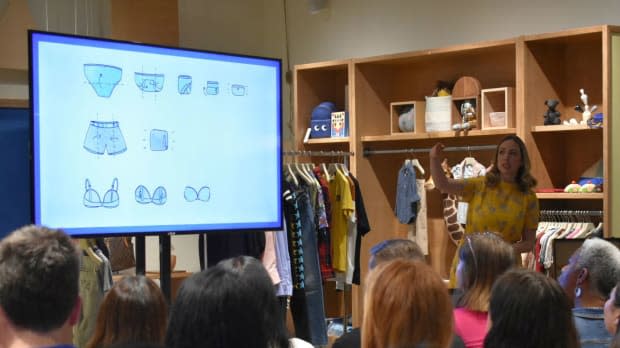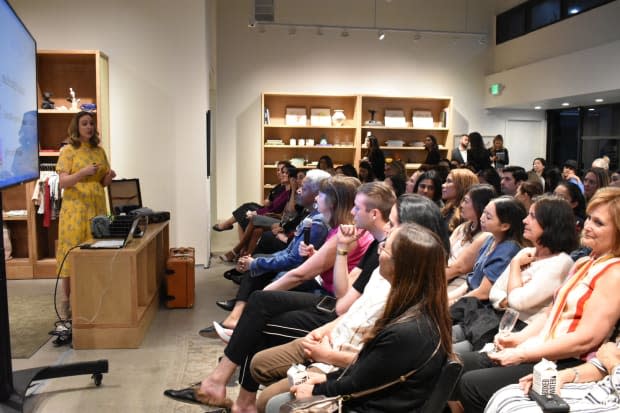9 Questions for a Marie Kondo-Certified 'Master'-Level KonMari Consultant
An expert on getting people to get rid of things explains how she does it.

On a Monday evening in West Hollywood, dozens of women excitedly lined up outside of The RealReal's Los Angeles flagship to sip champagne, shop and experience a master class by Caitlin Roberts. One of only two certified KonMari Method "master-level" consultants in the country, she learned the ways of tidying and organizing from Marie Kondo herself, and now helps to carry out Kondo's life goal of "organizing the world." Today, Roberts runs her own business, Minimize With Purpose, where she enters people's cluttered homes and guides them step-by-step through the rigorous KonMari process, commanding fees of up to $1,600 depending on the service.
If you've read "The Life-Changing Magic of Tidying Up" or watched Kondo's Netflix series "Tidying Up With Marie Kondo," or even simply had a conversation with a woman within the past three years, you're probably at least somewhat familiar with this process and the philosophy of getting rid of excess and only owning things that "spark joy." Still, it's a process that leaves many with questions, hangups and curiosities. So, we snagged some one-on-one time with Roberts to learn how she became a KonMari master, the biggest challenges her clients face and how the KonMari process actually changes people's personal style. Read on for the highlights.
How exactly did you end up becoming a KonMari master and what does that actually mean?
I used to work in an accounting office. I did all their operations and human resources and one day on my lunch break I was feeling a little stressed out and I saw on Pinterest Marie's book, 'The Life-Chaning Magic of Tidying Up' and I thought, 'Ok I'll read that later,' and then it came into my life three times in this hour and I thought, 'This is quite the serendipitous event; I should probably read this book and see what it is.' So I applied the method to my home and my life was changed and I never went back. So later that year, Marie — I was on her newsletter, it's as simple as that — decided her vision was to organize the world, so she sent out an email saying, 'I'm going to start training people because I don't work with clients anymore, so you can take this on and help me spread my mission.' I went and the initial step is a three-day, in-person course and it was taught in Japanese and this one was in San Francisco and they do this once or twice a year. I went and I had no idea that I would leave and start a business; I just went for fun and because I had enjoyed it. I had changed on my Linkedin that I had taken this course and by the time I came back from San Francisco, my first client had reached out to me.
To become certified you have to work 50 hours with clients that are approved, so I had to write reports and send videos and pictures of my work and answer very intense tidying questions, but it's really more about this technique of applying this philosophy to life, not just about 'how great do you fold?' So over the years I've just worked pretty steadily. In January, myself and one other person were designated masters. It means we worked with 50 people, completed more than 500 tidying lessons and it really has been nonstop ever since. I truly see people from the start to the finish of their home; we touch every single thing so I totally see them transform as a person.
What do you learn during the workshop?
When you go to this three-day workshop, you have to have already done the method in your home, so you had to send evidence of that. Everyone was expected to know the folding and all of the principles, so this was all about what is it like to work with a client at various levels of disorganization and really how to listen to them and pull out what is making them happy, what would they like to change. So it's a lot about that more than any strict techniques. You have to know the heart of it before you can apply the techniques.
Is what we see on "Tidying Up With Marie Kondo" an accurate depiction of what you do? Is there much they leave out?
Parts of it. What you don't see on the TV show is Marie could come in and spend a little bit of time with them but we actually are extremely hands-on. I will maybe assign homework to someone but I'm starting a category with them, getting them all the way through it. I hold their hand through the whole process and keep it focused and accountable and that momentum going. What you don't see on the show is that there were actually consultants that worked with those families so they filled in the blanks because there's only one Marie.
How are people able to fit all of this into their schedules? Do they usually take time off work?
I had someone who took a week off of work and maybe I'll get her started and she'll do a little bit on the weekends moving forward. A lot of people do this when they're in a major life transition: changing jobs or preparing to move, so it depends. The goal is actually to just do it as much as you can in your schedule but kind of cap it at six months because we don't want this to be going on for four years, because that happens.

What tend to be the biggest hurdles for people when getting rid of clothes?
It's two things. It's the changing of sizes: If someone just had a baby and it's who were they before they had the baby, and then they had maternity things and what made them feel good right after. But then it's also like, you're a totally new person. We evolve and change every day so it's really working through that, so that's why these initial first steps of identifying your ideal lifestyle and who you are and what you're working towards really helps you make those decisions because those are tough ones.
In terms of a quick fix for the closet, when people change out their hangers so that they're matching, it changes your whole closet so if someone needs something like that to just really feel good, I'll bring that up.
We don’t keep a lot of 'just in case' items unless it's like: I would buy this tomorrow for four times the cost. Those kinds of conversations help us get there.
Do people usually know what to do with all the stuff they're getting rid of? Do you advise them on places to donate, sell, etc.?
A lot of my clients already use The RealReal so they are familiar with it. There's women's shelters, animal shelters can always use linens, so I try to learn a little bit about them and what makes them passionate and excited because, actually, this really helps with the discarding step. When you know that someone can use these items that you've been just holding onto, you feel so good.
We steer them in that direction; [finding a charity they're passionate about is] a big part of our get-to-know-you process.
We're obviously entering a seasonal transition period, how do you advise people to store their winter items?
There's the New York trick, which is you store wintery items in your luggage. And if there's something you've grown out of, like a maternity clothing type thing, I do think that those suction bags are cool as long as you're not really going to be accessing it for a a while.
What feedback do you usually get from people after they've gone through this process?
Everyone says the exact same thing: They all walk through their home and say how light and free and [the] free-flow of energy they're experiencing and they'll talk about major changes that have happened, like maybe they finally booked that trip they were always talking about or maybe it came up that they really, really wanted to be a sewer; they had all this stuff but never had the time to do it. So they'll start picking up that hobby or whatever it is.
Do clients ever end up completely changing or redefining their personal style through this?
One-million percent. It's really fun to actually see that happen because they get stuck in what they used to love to wear but when you actually pull out their top-three favorites and we identify what it is [they] love about it, it's always: This is versatile, this is comfy, you can dress it up, dress it down. It's the same things, so I really try and highlight that because, oftentimes, we'll find things that have holes or might just need to be discarded, so we make a purposeful shopping list and the idea is that whatever goes on the list, you're going find something that also hits all of those elements. If you're just replacing a black cami, we know you want a certain cut, a certain fabric, it has to do all of these things that brought you joy in other items. I think it's always about highlighting whatever it was that was important to them.
Never miss the latest fashion industry news. Sign up for the Fashionista daily newsletter.
